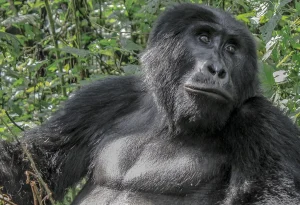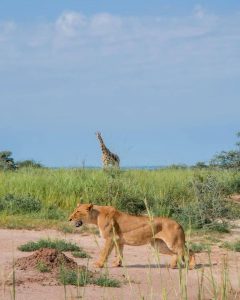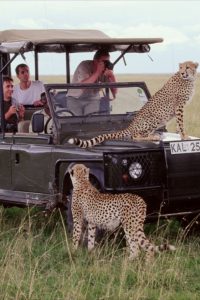Roles of Tour Guides During Gorilla Trekking
Roles of Tour Guides During Gorilla Trekking. Tour guides play an indispensable role in making gorilla trekking a safe, educational, and unforgettable experience. These guides are more than just leaders of a hike; they are educators, safety officers, conservation advocates, and cultural ambassadors. Their responsibilities are multifaceted, ranging from ensuring the safety of visitors to promoting conservation ethics, all while providing insights into the behavior and ecology of mountain gorillas. Here, we explore the various roles tour guides play during gorilla trekking, emphasizing how they contribute to the overall success and sustainability of this unique activity.
1. Leading and Managing the Trek
Tour guides are responsible for leading the group through dense forests, rugged trails, and often challenging terrain. Their expertise in navigation and group management ensures that the trekking experience is smooth and enjoyable.
- Route Navigation: Guides use their deep knowledge of the area to navigate the trails that lead to the gorilla families. This expertise helps trekkers avoid unnecessary detours or unsafe paths.
- Group Coordination: They manage the group, ensuring trekkers stay together and follow the designated trails. This prevents individuals from wandering off, which could lead to safety risks or disruption of wildlife.
- Time Management: Gorilla trekking is strictly regulated, with a specific amount of time allotted for viewing the gorillas (typically one hour). Guides ensure that the group adheres to this schedule to respect conservation guidelines while maximizing the visitor experience.
2. Ensuring Safety
Safety is a top priority during gorilla trekking, given the challenges posed by the terrain, wildlife encounters, and the physical demands of the activity. Tour guides are trained to handle these challenges effectively.
- Risk Assessment: Guides constantly assess the surroundings to identify potential risks, such as slippery trails, steep inclines, or encounters with other wildlife.
- Emergency Preparedness: They are equipped to manage emergencies, including medical issues like altitude sickness, dehydration, or injuries sustained during the trek.
- Distance Maintenance: To protect both gorillas and humans, guides enforce the rule of maintaining a 7-meter (21-foot) distance from the gorillas. This minimizes stress to the animals and reduces the risk of transmitting diseases between species.
3. Educating Trekkers
A significant role of tour guides is to provide trekkers with valuable insights into the lives of mountain gorillas, their habitat, and the broader conservation efforts.
- Behavioral Insights: Guides explain the gorillas’ behaviors, such as grooming, feeding, and social interactions, making the experience both educational and engaging.
- Conservation Awareness: Guides highlight the importance of gorilla conservation, discussing the threats these animals face, such as habitat loss and poaching, and the efforts being made to protect them.
- Ecological Context: They provide information about the broader ecosystem, including other flora and fauna that trekkers may encounter during the hike.
- Cultural Connections: Many guides share local myths, legends, and stories related to gorillas and the forests, offering a richer cultural perspective.
4. Facilitating Gorilla Viewing
Once the group reaches the gorilla family, the guide’s role becomes even more critical. They ensure that visitors get the most out of their experience while minimizing disturbance to the animals.
- Locating the Gorillas: Guides work closely with trackers, who go ahead of the group to locate the gorilla family. This teamwork ensures that the group has a high chance of encountering the gorillas.
- Behavior Moderation: Guides help trekkers interpret the gorillas’ actions, such as chest-beating or vocalizations, which can sometimes be intimidating. They provide instructions on how to respond appropriately.
- Photography Guidance: For visitors eager to capture photos, guides offer tips on camera settings and angles while ensuring that the activity does not disturb the gorillas.
5. Enforcing Conservation Rules
Tour guides play a vital role in ensuring that all activities during the trek adhere to strict conservation guidelines. These rules are essential for protecting the gorillas and their fragile habitat.
- Litter Prevention: Guides emphasize the importance of leaving no trace in the forest, ensuring that visitors do not litter or disturb the natural environment.
- Disease Prevention: Mountain gorillas share 98% of their DNA with humans, making them highly susceptible to human diseases. Guides enforce rules such as wearing masks and staying home if sick to protect the gorillas.
- Interaction Limits: Guides monitor the group’s behavior, ensuring that no one touches the gorillas or engages in actions that could stress or provoke them.
6. Liaising with Local Communities
Tour guides often act as bridges between visitors and local communities, sharing cultural insights and promoting sustainable tourism.
- Cultural Ambassadors: Many guides are locals who share their own stories and traditions, helping trekkers understand the cultural significance of the forests and gorillas.
- Community Benefits: Guides explain how gorilla trekking supports local communities through job creation and revenue-sharing programs, encouraging trekkers to appreciate the social impact of their visit.
7. Providing Emotional and Physical Support
Gorilla trekking can be physically demanding, especially for those unaccustomed to hiking in high-altitude, forested terrain. Guides play a crucial role in keeping morale high and assisting those who may struggle.
- Encouragement and Motivation: Guides provide words of encouragement to trekkers who may find the hike challenging, ensuring that everyone feels supported.
- Physical Assistance: For those who require help, guides are ready to lend a hand, whether it’s steadying a trekker on a steep path or carrying light gear.
- Calming Anxiety: Some trekkers may feel nervous about encountering wildlife. Guides help to ease these fears by explaining what to expect and how to act.
8. Post-Trek Engagement
The role of a guide does not end when the trek concludes. They often facilitate post-trek discussions and reflections, leaving a lasting impression on visitors.
- Feedback Collection: Guides gather feedback from trekkers to improve future experiences and address any concerns.
- Advocacy Inspiration: Many visitors leave inspired by their guides’ passion for conservation. Guides often encourage trekkers to support gorilla conservation initiatives or share their experience to raise awareness.
- Souvenirs and Stories: Guides recommend local crafts and souvenirs that benefit the community and serve as meaningful reminders of the trek.
Qualities of an Effective Tour Guide
An effective tour guide possesses a combination of knowledge, experience, and interpersonal skills. Key qualities include:
- Extensive Knowledge: About gorillas, ecology, and local culture.
- Strong Communication: The ability to convey information clearly and engagingly.
- Patience and Empathy: For addressing the needs and concerns of trekkers.
- Passion for Conservation: A deep commitment to protecting the environment and educating others about its importance.
Conclusion
Tour guides are the backbone of gorilla trekking experiences, ensuring that each trek is not only safe and enjoyable but also meaningful and educational. Their multifaceted roles—from navigating trails and ensuring safety to educating visitors and promoting conservation—make them indispensable to this activity. By fostering a deep respect for gorillas and their environment, tour guides contribute to the sustainability of this unique experience while leaving a lasting impact on trekkers. Their dedication ensures that gorilla trekking remains a transformative journey for all who participate.




